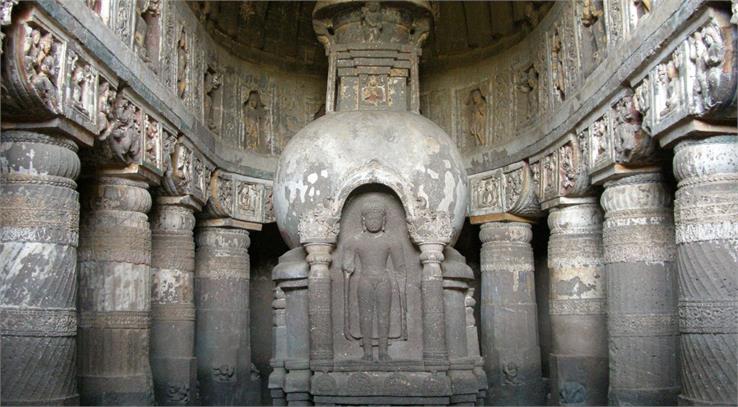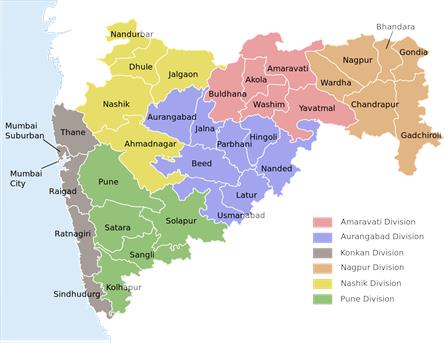Ajanta Caves: India's Ancient Artistic Marvel

The Ajanta Caves are nestled deep within the heart of India, in the state of Maharashtra. These caves are a treasure trove of history, spirituality, and artistry. This UNESCO World Heritage Site is not just a collection of caves but a window into the rich tapestry of India's past. Spanning over two millennia, the Ajanta Caves offer an unparalleled glimpse into the evolution of art, religion, and culture in the Indian subcontinent. So, let's journey through time to explore the enigmatic Ajanta Caves in all their glory.
Also Read: UNESCO World Heritage Sites of India
A Historical Tapestry of Ajanta Caves | Tranquill Space for Meditation
The Ajanta Caves, carved into the horseshoe-shaped rock formations of the Sahyadri Hills, date back to the 2nd century BCE. The caves served as a sanctuary for Buddhist monks, providing them with a tranquil space for meditation and worship. However, their significance extends beyond mere religious sites; they are a testament to the confluence of diverse cultures, artistic styles, and architectural brilliance.
The Cave Complex
The Ajanta Caves consist of 29 rock-cut caves, each with its own unique charm. They are divided into two groups: the earlier Hinayana caves (Caves 9-12) and the later Mahayana caves (Caves 1-8 and 13-29). These caves are known for their exquisite architecture and intricate frescoes, which depict various aspects of Buddhist life, teachings, and Indian society at the time.
Also Read: The Historic Agra Fort
The Artistry of the Frescoes
One of the most captivating aspects of the Ajanta Caves is the stunning frescoes that adorn their interiors. These intricate paintings showcase the life of the Buddha, his previous incarnations, and scenes from Jataka tales. The vibrant colors and meticulous detailing make these frescoes a marvel of ancient Indian artistry.
The Ajanta frescoes provide invaluable insights into the clothing, jewelry, and everyday life of people in ancient India. They also depict the multicultural nature of the caves' inhabitants, with influences from India, Central Asia, and beyond. These frescoes are not just beautiful works of art; they are historical documents that shed light on their time's social, religious, and artistic nuances.
Also Read: National Parks of India
The Evolution of Cave Architecture
The Ajanta Caves are a testament to the evolution of cave architecture in India. The early Hinayana caves are relatively simple in design, featuring plain facades and a central hall with a stupa. As Buddhism evolved and gained more followers, so did the complexity of the cave architecture. The later Mahayana caves are grander in scale, with intricately carved facades, ornate pillars, and multiple chambers.
Cave 26, also known as the Chaitya Griha, is a prime example of the advanced cave architecture at Ajanta. It boasts a stunning horseshoe-shaped window above the entrance, resembling a chaitya arch. The interior is adorned with a large Buddha statue flanked by intricate carvings, creating a serene and awe-inspiring atmosphere.
A Multicultural Legacy
The Ajanta Caves serve as a testament to the multicultural influences that shaped ancient India. While they primarily showcase Buddhist themes, the art and architecture within the caves also reflect elements of Hinduism and Jainism. This amalgamation of religious and cultural influences speaks to the spirit of tolerance and coexistence that prevailed in ancient India.
The Arrival of Western Awareness
The Ajanta Caves remained hidden from the Western world until their rediscovery in the 19th century. British officer John Smith stumbled upon them while hunting in the region in 1819. Their rediscovery opened a new chapter in the study of Indian history and art. Western scholars and archaeologists flocked to Ajanta, and their documentation and preservation efforts ensured that these caves would be preserved for future generations to admire.
Preservation Efforts
Over the years, the Ajanta Caves faced numerous challenges, including natural deterioration, vandalism, and inadequate maintenance. To address these issues and ensure the preservation of this cultural heritage, extensive restoration, and conservation work has been undertaken. The Archaeological Survey of India (ASI) has been instrumental in these efforts, employing cutting-edge technology and expert conservationists to safeguard the caves.
Visiting the Ajanta Caves Today
Today, the Ajanta Caves are a popular tourist destination, attracting visitors worldwide. The site is open to the public, allowing people to explore its rich history and artistic wonders. However, to protect the fragile frescoes and sculptures, certain areas of the caves are restricted, and flash photography is prohibited.
As you step into the caves, you will be transported back in time, surrounded by the ancient echoes of devotion and artistic brilliance. The play of light and shadow in the dimly lit caves adds to the mystique, making it a truly immersive experience.
The Ajanta Caves are a testament to ancient India's creativity, spirituality, and diversity. These caves offer a remarkable journey through time, revealing the evolution of art and culture in the subcontinent. As you explore the frescoes, sculptures, and architecture of the Ajanta Caves, you will feel a profound connection to the past and an appreciation for the enduring legacy of India's artistic marvels. It is a place where history, spirituality, and art converge, inviting us to reflect on the timeless beauty of human expression.












